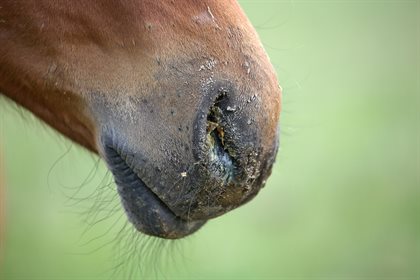|

|
This article first appeared in the May 2022 digital edition of Equestrian Life. To see what's in the current issue, click here.

Sinusitis: Not to be sneezed at
By Dr Maxine Brain
Sinusitis, as the name suggests, is an inflammation of the sinuses. Horses suffering with sinusitis can be frustrating for owners to deal with for a couple of reasons – one, that they often present with a nasal discharge that is persistent, smelly, and unsightly, and two, they can be difficult to resolve, often requiring surgical involvement to recover fully.
Sinuses are air-filled cavities within the skull that connect either directly or indirectly with the nasal passages, allowing an interchange of air, fluid, and infectious agents between the two. The horse has six paired sinuses in the skull, these being the maxillary sinuses, the frontal sinuses, the sphenopalatine sinuses, and the dorsal, middle, and ventral concha sinuses.
The frontal sinus is triangular-shaped and located below the skull bones that sit between the eyes and extends down to approximately midway along the facial crest. The frontal sinus communicates with the dorsal conchal sinus and can sometimes be referred to as the conchofrontal sinus. Frontal sinusitis can often occur because of trauma, as it becomes infected secondarily to the horse running directly into an object (especially trees), fracturing the front of the skull and introducing bacteria into the environment.
The maxillary sinus is the largest of the sinuses and is divided into rostral and caudal parts by a thin septum (bony wall). The caudal part of the maxillary sinus is the larger and communicates with the sphenopalatine sinus, the middle conchal sinus and the frontal sinus. In foals, the maxillary sinus is full of developing teeth, and by the time a horse has reached 5 to 6 years old, the sinus is filled with the embedded parts of teeth. As the horse ages the teeth move down from the sinus into the mouth to ensure enough tooth is present to compensate for the wear that occurs with grazing and chewing. By the time the horse becomes “old”, the maxillary sinus becomes more air filled and eventually all the teeth that occupied the region are lost...
Read the full article in the May 2022 issue of Equestrian Life magazine.
|

|

